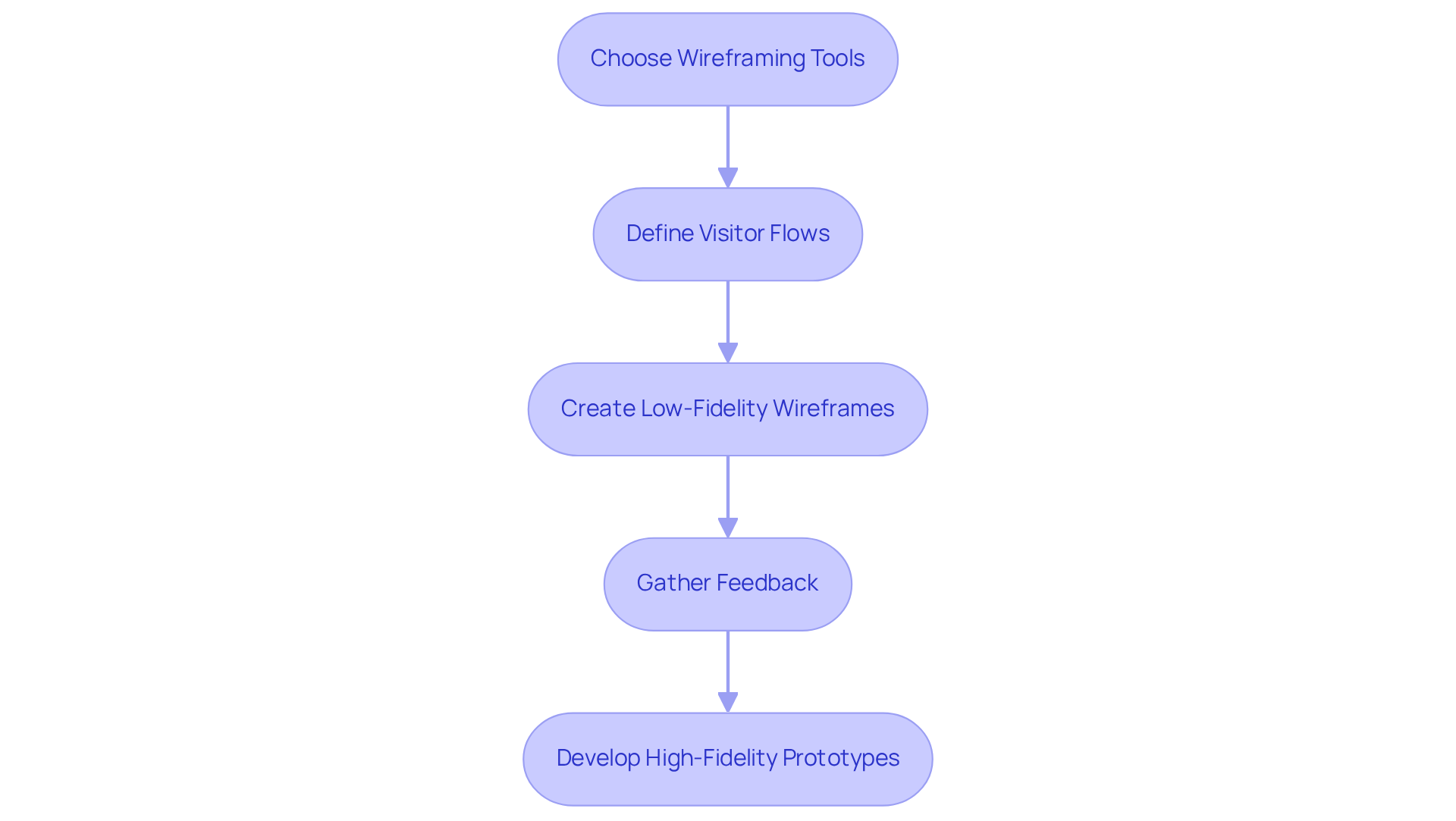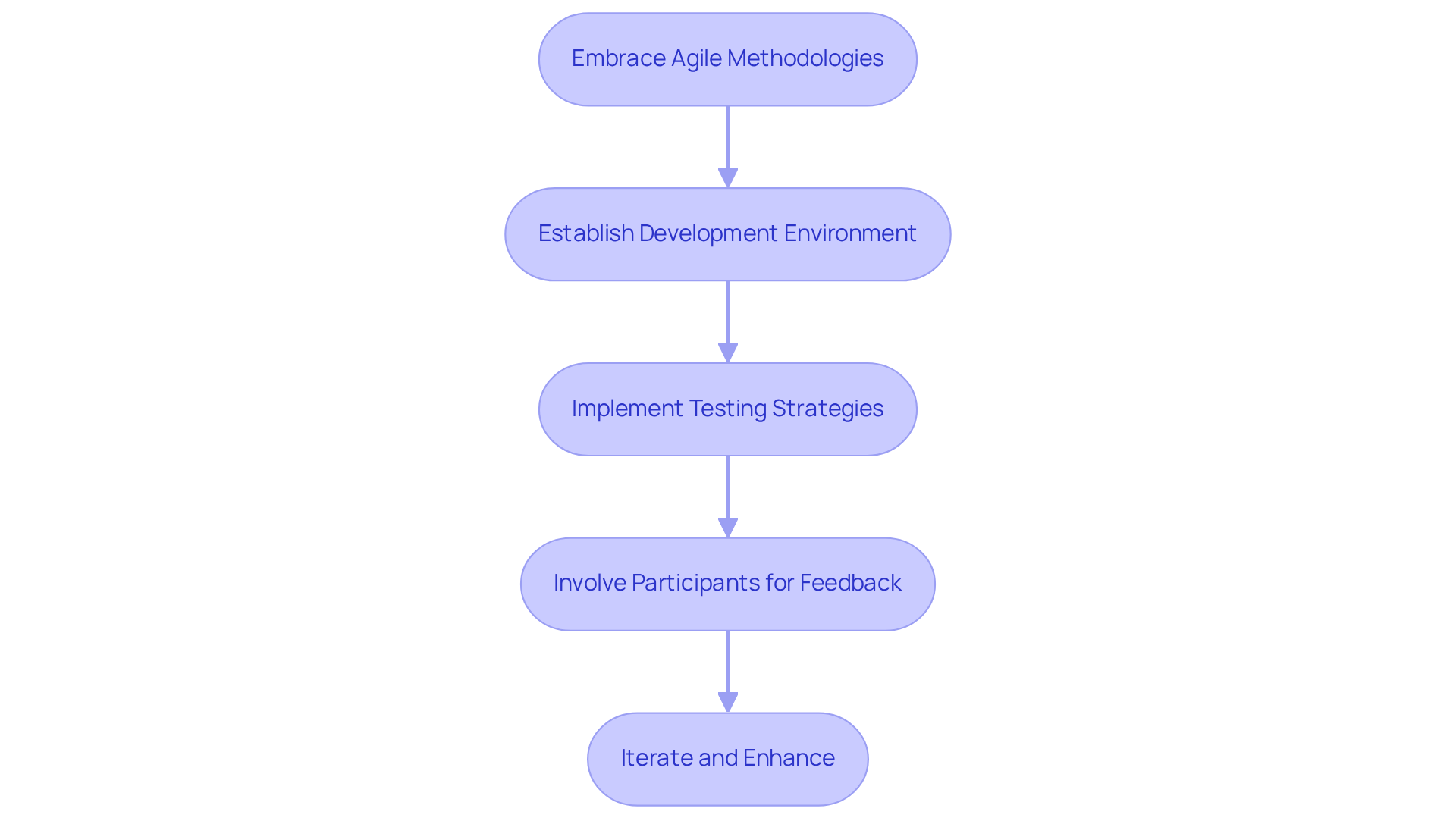AI
our blog
Master SaaS Development: 5 Steps for CTOs to Succeed

Overview
To master SaaS development, CTOs must navigate five essential steps:
- Defining requirements and goals
- Validating ideas
- Selecting the appropriate tech stack
- Creating wireframes
- Developing and testing the software solution
Each step underscores the critical importance of:
- Stakeholder engagement
- Market research
- Iterative feedback
- The utilization of effective tools and methodologies
This approach ensures that the final product not only meets user needs but also achieves project success. Furthermore, by prioritizing these elements, CTOs can enhance their credibility and drive impactful results in their organizations.
Introduction
Mastering SaaS development presents a significant challenge, particularly for Chief Technology Officers navigating a landscape filled with fierce competition and rapid technological advancements. This guide clarifies the essential steps required to successfully bring a SaaS product to market, offering valuable insights into:
- Defining requirements
- Validating ideas
- Selecting the right tech stack
Given the multitude of moving parts, how can CTOs ensure that their strategies not only align with market demands but also foster innovation and growth? By addressing these questions, we set the stage for a deeper exploration of effective SaaS development strategies.
Define Requirements and Goals for Your SaaS Product
-
Identify Stakeholders: Engage with all relevant parties, including team members, potential users, and business leaders. This inclusive approach ensures that diverse viewpoints are considered, which is crucial for successful development. Companies prioritizing stakeholder engagement achieve project success 83% of the time, compared to a mere 32% for those that do not. At Studio Graphene, we guide you through this process during the Discovery phase, ensuring that every voice is heard, thereby establishing a robust foundation for your digital solution.
-
Conduct Market Research: Analyze competitors and market trends to pinpoint essential features and gaps that your offering can address. Effective market research is indispensable for SaaS development, as it enables companies to comprehend customer needs and innovate for growth. For instance, 78% of small businesses have already invested in SaaS solutions, underscoring the demand for tailored offerings. Our Design phase at Studio Graphene integrates these insights to craft solutions centered on individuals, utilizing tools such as surveys and competitive analysis frameworks.
-
Set SMART Goals: Define Specific, Measurable, Achievable, Relevant, and Time-bound goals for your product. For example, aim to reach a specific number of individuals within the first year. Establishing clear objectives not only aligns teams but also boosts accountability, leading to a 20% increase in project success rates when stakeholder input is incorporated. Studio Graphene emphasizes this during the Build phase, ensuring that your goals are not merely aspirational but actionable.
-
Document Requirements: Create a comprehensive requirements document that details functional and non-functional requirements, user stories, and acceptance criteria. This document serves as a reference during the development phase, ensuring that all team members are aligned and informed. Our structured approach at Studio Graphene guarantees that this documentation is thorough and reflective of stakeholder input, employing templates and collaborative tools to enhance clarity.
-
Review and Revise: Regularly revisit and update your goals and requirements as new information emerges or as market conditions evolve. Continuous adaptation is vital in the fast-paced SaaS development landscape, where it is projected that 99% of companies will use at least one SaaS solution by the end of 2024. At Studio Graphene, we assert that this iterative process is essential for delivering successful digital solutions, reinforcing the financial benefits of effective stakeholder engagement.

Validate Your Idea and Seek Expert Consultation
-
Conduct Participant Interviews: Engage potential participants to gather insights about their needs, preferences, and pain points. This qualitative information is crucial for enhancing your concept, as studies indicate that approximately 42% of startups fail due to insufficient market demand for their offerings. By conducting comprehensive interviews with customers, you can gain a clearer understanding of the market environment and align your offering with genuine consumer needs. For instance, in developing the logistics platform for Alchemy Wings, we scrutinized the requirements of various stakeholders, including delivery partners and vendors, ensuring that the design prioritized the needs of the end-users.
-
Create a Minimum Viable Version (MVP): Develop a streamlined iteration of your offering that encompasses only the essential features needed to address the primary consumer issue. This approach allows you to evaluate your idea with actual participants, significantly reducing costs associated with saas development by as much as 60% compared to traditional methods. Startups involved in saas development utilizing MVPs often experience 30% more modifications than those employing conventional techniques, enhancing their likelihood of meeting market demands. In our case, we implemented a reverse auction feature for order fulfillment, which was vital for connecting delivery companies and optimizing logistics.
-
Utilize Surveys and Feedback Tools: Implement online surveys to collect quantitative data on participant interest and feature preferences. Tools such as Google Forms or Typeform can facilitate this process, enabling you to gather actionable insights that inform your product direction. For Alchemy Wings, leveraging existing technologies like Google Maps for measuring distances and journey times was crucial in refining our service based on user feedback.
-
Seek Expert Consultation: Reach out to industry experts or mentors who can provide guidance and feedback on your idea. Their experience can help you identify potential pitfalls and opportunities, ensuring that your MVP is well-positioned for market success. As Vasyl Kuchma emphasizes, having a supportive team is vital for navigating the complexities of MVP development. In our project, integrating with platforms like Companies House and Brandbank streamlined the onboarding experience for vendors, highlighting the importance of expert insights.
-
Iterate Based on Feedback: Leverage the insights gained from audience interactions and expert consultations to refine your concept. This iterative process is essential, as roughly 72% of startups adopt the MVP strategy, enabling them to pivot or modify their offerings effectively based on client feedback. For Alchemy Wings, we developed an intuitive mobile app and web platform that provided detailed sales data and delivery validation, ensuring continuous improvement of the user experience.

Select the Appropriate Tech Stack for Development
-
Assess Project Requirements: Begin by identifying the specific needs of your project, including scalability, security, and performance requirements. This foundational step informs your tech stack decisions. With numerous cloud service providers and DevOps tools available, it is essential to utilize those that align with your product, technical, and budgetary requirements.
-
Identify Cloud Platforms and DevOps Tools: Explicitly identify the cloud platforms and DevOps tools that best fit your project’s needs. Consider critical features such as scalability, security, and integration capabilities, which are essential for successful implementation.
-
Evaluate Popular Tech Stacks: Conduct thorough research on widely-used tech stacks such as MERN, MEAN, and LAMP. Each stack presents unique advantages and disadvantages that should align with your project’s objectives, ensuring that you make an informed choice.
-
Consider Team Expertise: Take into account the existing skill set of your development team. Opting for technologies that your team is already proficient in can significantly reduce training time and enhance overall productivity, leading to more efficient project execution.
-
Plan for Scalability: It is crucial to select a tech stack capable of accommodating growth. Prioritize SaaS development solutions that facilitate seamless scaling as your user base expands, ensuring that performance remains optimal. Strategic selection of cloud platforms and DevOps tools will play a pivotal role in this procedure.
-
Prototype and Test: Before committing to a tech stack, develop a small prototype to evaluate the integration of various technologies. This method enables you to identify potential issues early in the development phase, thereby reducing risks and ensuring a smoother implementation.

Create Wireframes and Design User Interfaces
-
Choose Wireframing Tools: Selecting effective wireframing tools such as Figma, Sketch, or Balsamiq is essential. These platforms facilitate the rapid creation of low-fidelity wireframes, thereby streamlining the initial design process.
-
Define Visitor Flows: Mapping out visitor flows is crucial for understanding the journey through your application. Identify key interactions and touchpoints to inform your wireframe design. Effective flow mapping can significantly enhance the user experience; studies indicate that UX improvements can boost conversion rates by as much as 400%.
-
Create Low-Fidelity Wireframes: Start with simple sketches to outline the layout and structure of your application. At this stage, prioritize functionality over aesthetics to ensure a well-defined core experience.
-
Gather Feedback: Share your wireframes with stakeholders and prospective clients to collect valuable feedback. Prompt recognition of usability challenges can save time and resources; a prototype can effectively convey design ideas and interactions, potentially preserving a thousand hours of discussions.
-
Develop High-Fidelity Prototypes: After validating your wireframes, create high-fidelity prototypes that incorporate visual design elements. This step provides a clearer depiction of the final outcome, facilitating further testing and refinement. As emphasized by UX experts, a clearly outlined user flow is essential for product success, underscoring the necessity for ongoing assessment and enhancement throughout the design process.

Develop and Test Your SaaS Software Solution
-
Embrace Agile Methodologies: Adopting Agile practices is essential for fostering iterative development and continuous feedback. This method enhances flexibility, enabling teams to make swift adjustments based on consumer insights—an indispensable factor in addressing evolving market demands.
-
Establishing a robust SaaS development environment is crucial for the success of SaaS projects. Incorporating version control systems, such as Git, along with continuous integration and continuous deployment (CI/CD) pipelines streamlines workflows and bolsters collaboration among team members.
-
Implement Comprehensive Testing Strategies: Regular testing is vital to ensure software reliability. Employing a variety of testing methods—including unit testing, integration testing, and acceptance testing (UAT)—validates that the software performs as expected and meets established requirements.
-
Involve Participants for Feedback: Engaging participants actively during the testing phase is essential for collecting authentic feedback. This practice helps identify usability issues and improvement opportunities, ensuring that the final outcome aligns with both expectations and requirements.
-
Iterate and Enhance: Utilize the feedback obtained during testing to refine and enhance the software. This iterative process is critical for making necessary adjustments before the final launch, ultimately leading to a more successful product that resonates with users.

Conclusion
Mastering SaaS development necessitates a structured approach that includes:
- Defining clear requirements
- Validating ideas
- Selecting the appropriate technology
- Designing user interfaces
- Implementing robust development practices
By adhering to these outlined steps, CTOs can adeptly navigate the complexities of creating successful SaaS products, ensuring alignment with market demands and stakeholder expectations.
Key strategies involve:
- Engaging stakeholders to gather diverse insights
- Conducting thorough market research to identify gaps
- Establishing SMART goals that foster accountability
The iterative process of developing a Minimum Viable Product (MVP) facilitates real-world testing and adaptation based on user feedback, while the careful selection of the tech stack guarantees scalability and performance. Moreover, prioritizing user experience through effective wireframing and testing strategies significantly enhances product viability and user satisfaction.
Ultimately, the journey of SaaS development is dynamic, requiring ongoing refinement and adaptation. By embracing these best practices, CTOs can not only innovate but also strategically position their companies for long-term success in the competitive SaaS landscape. Engaging with experts, leveraging user feedback, and committing to agile methodologies will empower the creation of products that resonate with users and meet evolving market needs.









